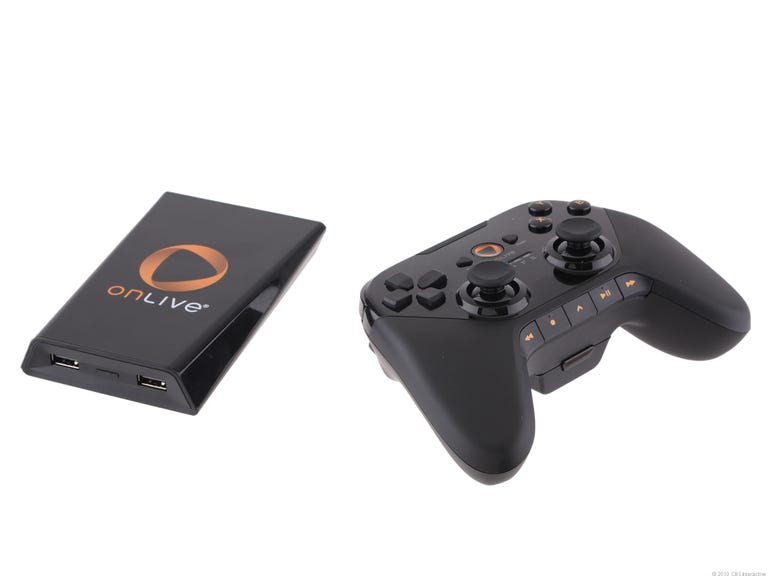 Why You Can Trust CNET
Why You Can Trust CNET OnLive MicroConsole review: OnLive MicroConsole
OnLive MicroConsole
If you're not familiar with the OnLive streaming game service, it's essentially cloud-based PC gaming. The original PC client allows nearly any laptop or desktop to play high-end PC games by offloading the CPU- and GPU-intensive tasks of actually running the game software to a remote render farm, then beaming the gameplay back to you as a streaming video.
The Good
The Bad
The Bottom Line
As a $99 set-top box, OnLive's new MicroConsole offers an intriguing low-cost alternative to traditional living-room game consoles, which can cost two to three times as much. Ditching the computer altogether, the MicroConsole acts as a dongle and media streamer, connecting to your TV via HDMI (or component video) and to the Internet via an Ethernet cable (Wi-Fi is still wonky on the PC client, so we don't expect to see it on the MicroConsole anytime soon).
The PC-based version worked surprisingly well, so our expectations were high for this standalone TV-friendly box. And, taking the $99 price into account, which includes a free game of your choice on the OnLive service, a wireless controller, and an HDMI cable, those expectations were largely met, although the image quality and features still can't match a full-price living-room game console. One caveat: the system requires a 3-5Mbps connection to work, and can be unforgiving of spotty Internet access speeds.
Setup and games
If you have an existing account (which is free to sign up for) you can log directly into it, and access games that have already been purchased. One of the nice features of cloud-based gaming is that your existing saved games and library travel with you wherever you log in. Otherwise you'll be able to follow onscreen prompts to set up a new account, either by inputting info via the gamepad (cumbersome), or by connecting a USB keyboard (easier).
The MicroConsole onscreen interface is identical to that of the PC client, and includes a marketplace for buying games (you're actually buying a license to play the game on OnLive's servers), a list of your purchased games, and an arena view, which lets you drop in and watch other players' live game streams (this can be turned off in the privacy settings).
In the marketplace, most games are $20 to $40, and the catalog consists mostly of slightly out-of-date mainstream games (Splinter Cell: Conviction, Borderlands), a handful of newer games (Mafia II), and some indie/casual games (Puzzle Chronicles, World of Goo). Many of the games can also be rented for three to five days for just a few dollars, and many offer a free trial period, allowing for copious low or no-cost sampling.
OnLive has also just released a beta for its all-you-can-eat package, which is available on both the MicroConsole and PC software client. For $9.95, the PlayPack plan currently includes 14 games, but not many of the most recent or high-profile games available in the a la carte menu.
Gameplay and lag
The system includes a solidly built wireless controller, which looks and feels a lot like a third-party Xbox 360 gamepad. But the bundled controller also seemed to have a small amount of built-in lag, even when navigating the system menus, making it the weakest link in the package. We were able to swap in a wired Xbox 360 controller, which felt more responsive.
Either controller choice worked well for third-party action games, such as Darksiders, but first-person shooters were tougher. We'd chalk that up to a couple of factors. First, even the slightest bit of lag can throw off your FPS experience, and second, we were using a gamepad to play a PC shooter.
OnLive works well on PCs, because you're playing the PC versions of these games. Connected to a TV, however, it's important to remember that you're still playing the PC version, not the console version. That's especially important in first-person shooters, where the console versions often have snap-to-aim assist features, but the PC versions do not.
However, when we plugged in a standard keyboard and mouse (using the two USB ports on the front of the MicroConsole), our FPS experience improved considerably, no doubt giving comfort to PC-only gamers who swear that a mouse/keyboard combo is the only way to really play a shooter. It still wasn't as tight as playing a game installed directly on a high-powered PC, but it was certainly very playable.
Resolution and output settings
OnLive says the MicroConsole "supports" full 1080p signals (and 5.1 audio), but the image quality doesn't match what you'd get from plugging a high-definition game console directly into your TV. Images typically ranged from good to very good, with occasional compression artifacts and a slightly softer focus than we're used to. Still, the image quality could also be excellent at times (on a 50-inch Samsung PN50C7000), especially considering this is a $99 all-in-one solution that doesn't require a computer to run.
Note that you can't change the screen resolution of games or other image settings. If the game you're playing has these as menu options, they're either grayed out or missing from the OnLive versions of these games. The company decides the optimal settings and runs the games from its own servers, leaving you with less control.
Hardware aside, the system will live or die based on its software catalog, which currently has a decent selection of recent games, including Mafia II, Splinter Cell Conviction, and Lego Harry Potter, but is missing hot PC-centric games such as Call of Duty: Black Ops or Civilization V. The Coming Soon section of the dashboard, however, looks very promising for 2011; it includes Fear 3, Deus Ex: Human Revolution, and Homeland.


